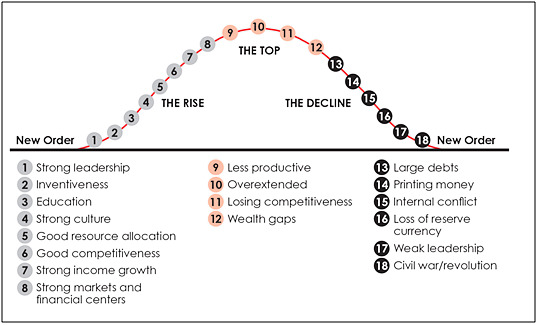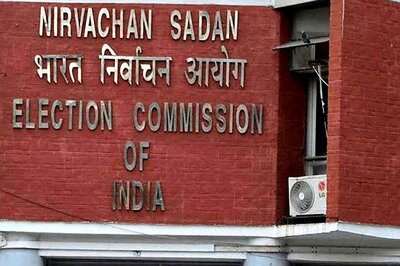
views
Ray Dalio, the legendary investor and founder, co-chairman of Bridgewater Associates, world’s largest hedge fund, in his recently published book titled “Principles for Dealing with the Changing World Order: Why Nations Succeed and Fail” has thoroughly examined history’s most turbulent economic and political events and eloquently identified comprehensive indicators that can be applied to understand today’s macroeconomic picture of the world. He emphasised on cyclical yet evolutionary nature of the relative wealth and power that have caused rise and decline of empires throughout the history. With 18 important determinants crystallised to explain relative position of a country through a comprehensive economic health index, Ray’s analysis has put India’s growth rate way above the global average for the upcoming decade.

Source: Principles for Dealing with the Changing World Order: Why Nations Succeed and Fail
The book categorises India as a modest power — positioned at number six among major countries today. It refers, India is in the gradual ascent with its strong economic and financial position and its cost competitive labour as key strengths. However, on the flip-side, India’s performance may be jeopardised by large domestic conflicts, weak position in education, poor performance on innovation and technology, corruption, inconsistent rule of law and its lack of reserve currency status.
I discuss how these weak points can be strengthened to ensure India’s ascent on the development trajectory.
Education and innovation are two fundamental pillars for any country to develop. India’s expenditure on education is gradually rising. In 2015, budgetary expenditure on education was 2.8 per cent of the GDP which increased to 3.5 per cent of the GDP in the year 2020-21. Despite steady increase in expenditure, the infrastructure in government schools remains below par. For instance, out of 9.72 lakh government schools, only 20.7 per cent have computers, 67 per cent have electricity while 70 per cent have playground and 83 per cent have a library.
Although India has attained 96 per cent literacy at the elementary school level, there are glaring disparities among socio-religious groups and gender. No wonder, such backlog during schooling years reflects our state of innovation. India’s rank was 81 in Global Innovation Index (GII) in 2015 which has improved to 48 in 2020. Despite this improvement in ranking much is left to be done for the government and the private sector collectively to build a sustainable innovation ecosystem.
Holistic approach to education from pre-school to higher secondary level is required with particular focus on teachers and technology. In this age of technology, computer literacy is equally important along with numerical and language literacy. Focus on science and mathematics learning can help improve analytical and cognitive abilities of a child. New Education Policy-2020 (NEP 2020) rightly emphasises on multi-dimensional development through vocational education, sports and physical education. It also promotes examinations, testing core competencies than memorising facts. With implementation of NEP-2020 and steady increase in expenditure on education, I believe we can plug the loopholes in our education sector.
On innovation front, businesses must come together and promote more expenditure on R&D. At present only 37 per cent of the gross expenditure on R&D in India comes from private sector while this number is 68 per cent (average) in each of the top 10 economies in the world. The government does a disproportionate amount of heavy lifting on R&D by contributing 63 per cent of the gross expenditure on R&D, which is three times the average contributed by governments in the top 10 economies. Yet, our gross expenditure on R&D at 0.65 per cent of the GDP is much lower than that of the top 10 economies. Indian residents contribute only 36 per cent of patents filed in India as compared to 62 per cent on average in the top 10 economies. Indian firms also perform below expectation on innovation for their level of access to equity finance, which is the most crucial for innovation.
Domestic conflicts and inconsistent rule of law are two significant indicators, according to Ray Dalio, that may impede India’s ascent. Domestic conflicts, particularly in the form of breaking down of law and order situation in a state or region, have significantly reduced in recent years. The last decade (2011-2020) has been one of the most peaceful and prosperous for India. The National Crime Records Bureau (NCRB) data suggests incidents of rioting and acts of terrorism have come down in large parts of the country. Barring few border states, no major terror threats or incidents have taken place in mainland India during the last seven years. State governments are responsible for law and order, but cross-border export of terrorism and anti-social elements is on the decline — thanks to a strong government in Delhi. Rapid digitisation and faceless assessment will help reduce corruption opportunities in the system.
I am confident that India will overcome these impediments and rise amid a changing world order. The opportunity for us to grow has never been better, and government and civil society need to work closely and transparently to bring in this change.
Sudhir Mehta is Chairman & Managing Director, Pinnacle Industries Limited; President, Mahratta Chamber of Commerce, Industries and Agriculture (MCCIA), Pune; Lead & Coordinator, Pune Platform for COVID-19 Response. The views expressed in this article are those of the author and do not represent the stand of this publication.
Read all the Latest Opinions here




















Comments
0 comment